GSM_Shield_SKU__TEL0097 - jimaobian/DFRobotWiki GitHub Wiki
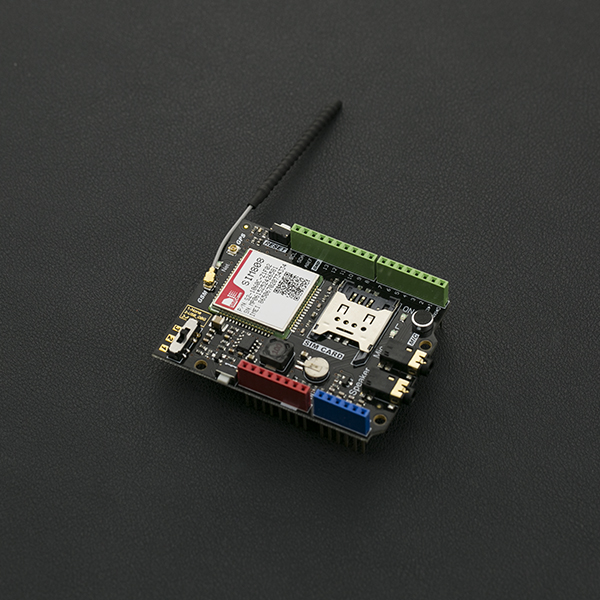
SIM808 GPS/GPRS/GSM is an integrated quad-band GSM/GPRS and GPS navigation technology Arduino expansion shields. A credit card size only, according to the standard Arduino pin packaging, compatible with Arduino UNO, Leonardo, Mega and other mainboard. Compared to the previous generation SIM908, SIM808 made some improvement on the performance and stability. In addition to the normal SMS and phone functions, the shield also supports MMS, DTMF, FTP and other functions. You can achieve the data acquisition, wireless data transceiver, IoT application and GPS orientating. The should integrates onboard microphone and headphone jack, saving your cost and making your project easily. it can also directly connect to the GSM and GPS antenna by an external antenna connector. SIM808 GPS/GPRS/GSM Shield V1.0 uses the latest version of Simcom SIM808 module, compared with the early SIM808 module available in the market, the new module has better stability. But GPS part of AT commands are not compatible with the old version of the SIM808 module, please refer to the bottom of the "more" in the AT commands.
- Operating voltage: 5V
- Input Power: 7-23V
- Quad-band 850/900/1800/1900MHz
- GPRS multi-slot class 12/10
- GPRS mobile station class B
- Comply with GSM phase 2/2 +
- Class 4 (2 W @ 850 / 900MHz)
- Class 1 (1 W @ 1800 / 1900MHz)
- Support low power consumption mode: 100mA @ 7V-GSM mode
- Support AT command control (3GPP TS 27.007,27.005 and SIMCOM enhanced AT Commands)
- Support GPS satellite navigation technology
- Support LED status indicator: Power supply status, network status and operating modes
- Working environment: -40 ℃ ~ 85 ℃
- Size: 69 * 54mm/2.71 * 2.12 inches
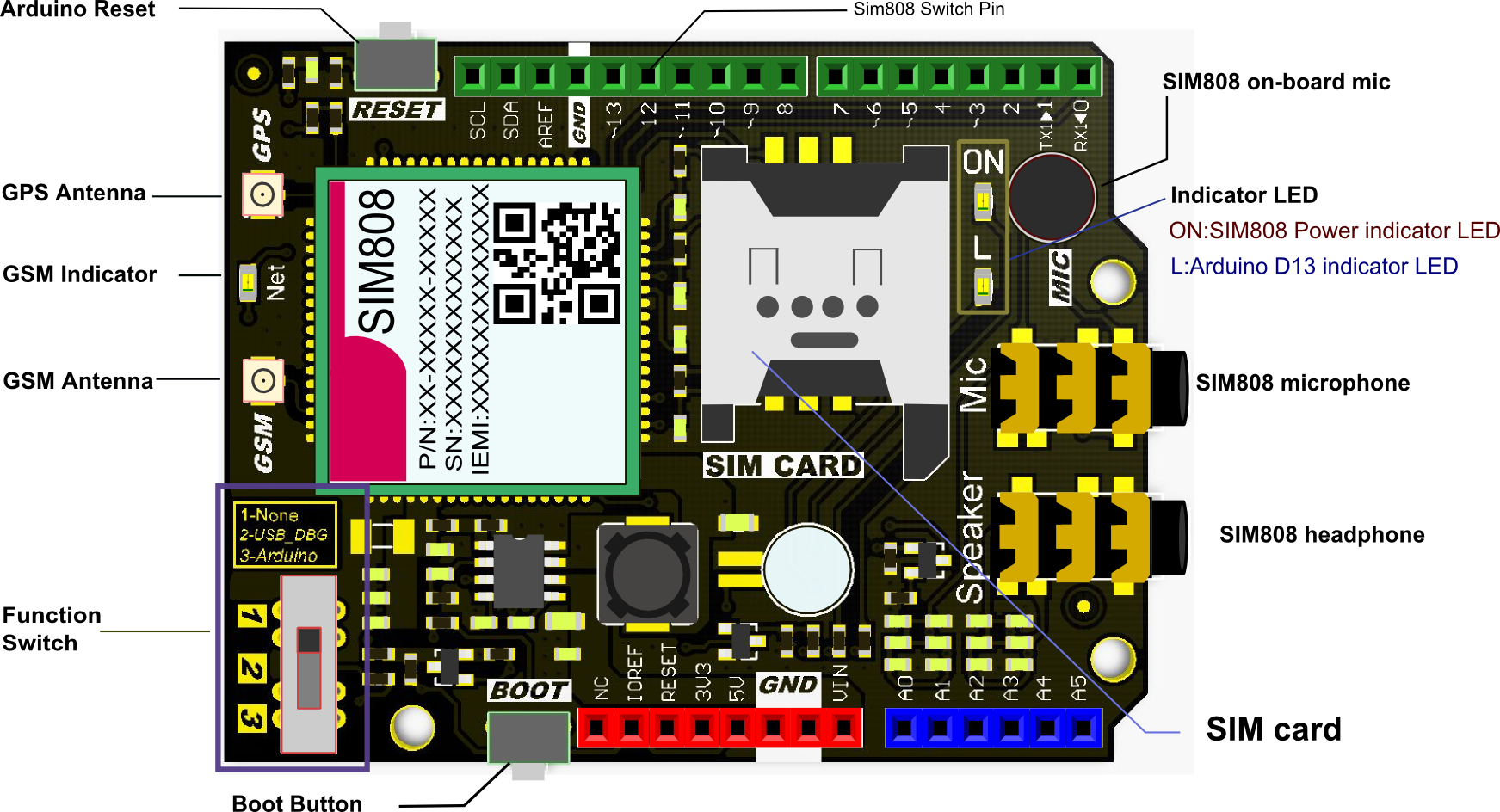
Module interface and precautions:
-
Occupied pins: D0, D1, D12, the digital pin "D12" is connected to SIM808 module power GPIO. It can be used as SIM808 module on / off control.
-
SIM808 onboard MIC and 3.5mm SIM808 microphone are using the same MIC channel, when you plugin your microphone, the on-board MIC will be automatically disconnected.
-
Boot switch button --SIM808 module switch, short-press 1s to start SIM808 , long-press 3s turn it off.
-
LED "ON" - SIM808 power indicator, only when you connect an external power, the module can work properly.
-
Net - GSM signal indicator
- Fast Flash: Search Network
- Slow flash (3s once): network registration complete
-
Function switch
- None-- Vacant SIM808 serial pin to download the sketch, please dial to here.
- USB_DBG-- When the expansion board plugged on the Arduino, dial to here to make SIM808 communicate with PC to make a debug (AT debugging).
- Arduino-- When the expansion board plugged on the Arduino, dial to here to make SIM808 communicate with Arduino.
In this section, we will send AT commands through the serial port to debug SIM808 expansion shield. Please refer to SIM808 AT command set for more function.
- Hardware:
- Arduino UNO x1
- SIM808 expansion board x1
- External power supply x1
*Software :
-
- Arduino IDE Click to Download Arduino IDE from Arduino®
- Serial debugging assistant (In this section, we are using DF Serial Debugger by Lisper)
‘’‘STEP’‘’
- Plug your SIM card on the SIM808 expansion shield and plug the expansion shield on Arduino UNO, meanwhile don't forget to connect an external power source.
- Dial the function switch to None, download a sample code Blink to make sure the serial port is not occupied.
- Press the Boot power button and wait for the SIM card registering a network properly, the Net indicator led flashes slowly (3s once).
- Slide the function switch to USB_DBG, then we can communicate directly with SIM808 chip through the serial port assistant.
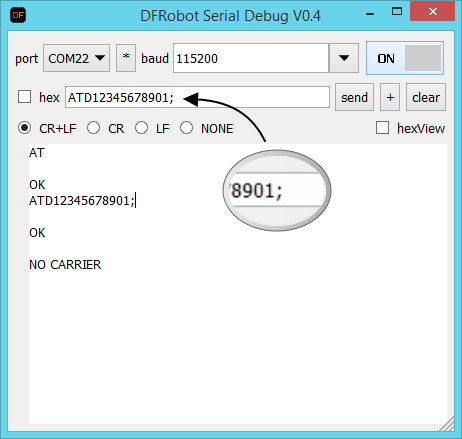 send at in the serial port assistant, if it returns ok, it means that serial communication has been established. follow the Figure, enter AT commands, you should get the same content.
send at in the serial port assistant, if it returns ok, it means that serial communication has been established. follow the Figure, enter AT commands, you should get the same content.
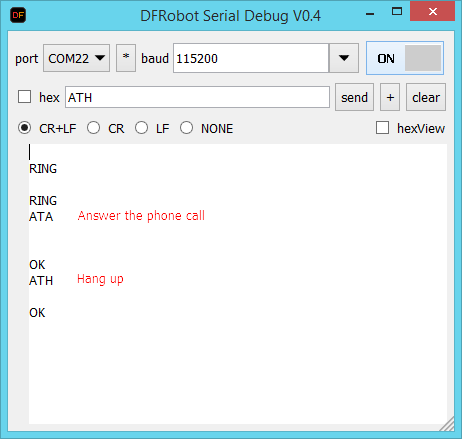

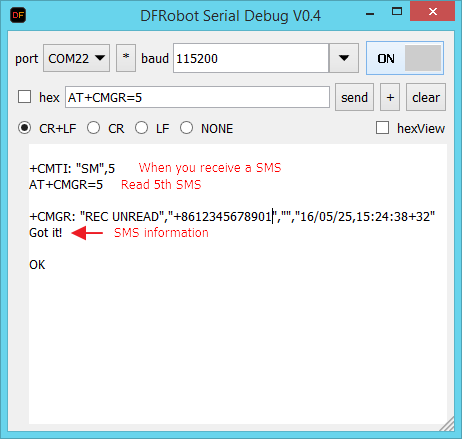
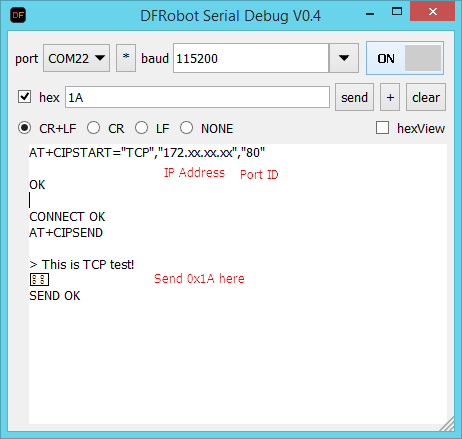
Note: The GPS antenna must be placed outside before it can obtain a stable GPS location data output.
Send AT + CGSN PWR = 1 command (Open the GPS power)
Send AT + CGNSTST = 1 command (Receive GPS data from the serial port)
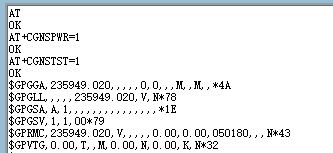
If the GPS antenna has been placed outside, you should get the right data soon.
When you want to pause GPS data output, you can sent AT + CGNSTST = 0 command to pause GPS data output.
When you want to turn off GPS function, you can send AT + CGNSPWR = 0 command to turn off the GPS power. Send AT + CPOWD = 1 to shut down the SIM808 chip.
More exciting instruction, please refer to AT command on the page of the end.
In the previous steps, we have achieved the basic function via USB debug. But it requires a PC. In this section, we'll tell you how to use Arduno to drive SIM808 GPS/GPRS/GSM Shield.
- Plug your SIM card on the SIM808 expansion shield and plug the expansion shield on Arduino UNO, meanwhile don't forget to connect an external power source.
- Dial the function switch to None, download the following sample code.
- Dial the function switch to Arduino, make sure SIM808 could communicate with Arduino board.
- Press the Boot power button and wait for the SIM card registering a network properly, the Net indicator led flashes slowly (3s once).
void setup()
{
Serial.begin(9600);
//wait for "call ready"
delay(5000);
}
void loop()
{
//Send AT command
Serial.println("AT");
delay(2000);
//make a phone call to 137XXXXXXXX
Serial.println("ATD137XXXXXXXX;");// 137XXXXXXXX is the phone number, don't forget ";" in the end
while(1);
}void setup() {
Serial.begin(9600); //initialize the serial baudrate
delay(5000);
}
void loop() {
Serial.println("AT");
delay(2000);
Serial.println("AT+CMGF=1"); //Set TXT mode
delay(2000);
Serial.println("AT+CMGS=\"137xxxxxxxx\"");//137xxxxxxxxxxx is the phone number
delay(2000);
Serial.print("Hello, this is a test"); //message context
delay(2000);
Serial.write(26); //send hexadecimal number "0x1A"
while(1);
}These two test code are very simple, and easy to be understood. Only need to enter the corresponding serial AT commands, you would achieve the corresponding functions.
The system will be reduced to a simplest mode under Minimum Functionality Mode. It will save more power consumption in this mode.
-
AT+CFUN= =0,1,4
- AT + CFUN = 0: Minimum functionality mode. In this mode, you can still continue to use the serial port, but the AT command with RF and SIM card features will be disable.
- AT + CFUN = 1: Full-function mode (default).
- AT + CFUN = 4: Airplane mode. In this mode, you can still continue to use the serial port, but the AT command with RF and SIM card features will be disable.
More features please refer to AT commands
If you are going to use SIM808 GPS/GPRS/GSM Shield with a Leonardo board, it will be more like a SIM808 GPS/GPRS/GSM mainboard. You can check its wiki for the user manual.
SIM808 GPS/GPRS/GSM Shield schematic NEW SIM800 Series GNSS Application Note V1.00 SIM800 Series AT Command Manual V1.07 SIM808 Hardware Design_V1.00 SVG file
 shopping from dfrobot store or dfrobot distributor.
shopping from dfrobot store or dfrobot distributor.